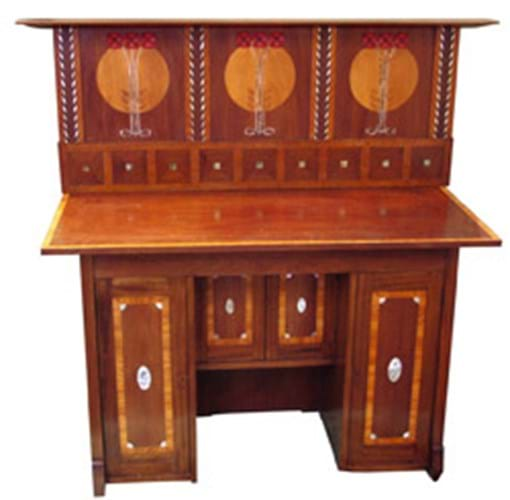
It is a somewhat unsatisfactory piece of furniture. The top section, with its fine 'Glasgow' inlays of pewter, abalone, purpleheart, sycamore and cherry, is pure Baillie Scott. The base, crossbanded with satinwood and embellished with mother of pearl, is perhaps his design but is clearly by a different hand.
However, tucked away on page 21 of his Mackay Hugh Baillie Scott, An Architectural History, where this piece is pictured, Gregory John Slater sheds light on just whose that hand may be.
It is possible the base of the sideboard was made during the years of the Great War by internees of the Knockaloe Mooar Aliens Detention Camp - a 22 acre plot of farmland on the west coast of the island that by 1917 held 23,000 'enemy aliens', mostly of German origin.
That the inmates were put to work on more than just utilitarian furniture for the Friends' War Victims Relief Committee is not a flight of fancy. One of the island's most famous sons, Archibald Knox, worked as the censor at Knockaloe.
In 1919 he wrote a letter to a member of the Guild of Handicrafts describing life in the camp and spoke about the Book of Kells as 'the work of angels', and it is known that designs by Charles Rennie Mackintosh for the industrialist W.J. Basset-Lowke were produced there.
Mackintosh furniture - including a bedroom suite in the Hunterian Museum and Art Gallery - is thought to have been made under the supervision of Charles Matt, who before the War had been the foreman in charge of 80 men at a London furniture factory.
The story is that this sideboard was given as a leaving present from the internees of Knockaloe to their camp dentist Norman McArthur Douglas.
Little is known of its subsequent history but in 1980 it was sold at Chrystals for a nominal sum before appearing with a fuller description, suggesting Baille Scott as the designer, at Sotheby's in 1983. It did not sell but the vendor had more joy now selling it 25 years later.
Given its status as a hybrid, this was not a piece of furniture for the purist, but there was no doubting its significance as a Manx historical artefact.
Estimated at £15,000-25,000, it was knocked down to a local buyer who lives in a Baillie Scott house at £17,600 (plus 10 per cent buyer's premium).




